Energy Consumption Difference Found between Typical and Standard Occupancy in Residential Buildings in a Tropical Developing Country
Abstract
:1. Introduction
2. Materials and Methods
2.1. Description of the Case Study
2.2. Survey
- General characteristics of the building and the occupants correspond to the first section, which included 17 questions that sought to know the number of people living in the residences, their ages, and monthly income. As for the building aspects: year of construction, area, years of construction, and materials that make up the windows, walls, doors, and roof.
- Ventilation and refrigeration systems: focused on knowing the amount of air conditioning equipment and fans. It comprises 11 questions.
- Water heater and use of gas and electrical items: it consisted of 15 questions, which allow us to know the number of appliances and their period of use, the average monthly energy consumption of the house, and the month where it is higher.
2.3. Typical Occupant Behavior Estimation
Frequency Analysis
2.4. Dependence on Energy Consumption through Correlation Analysis
2.5. Comparison of Typical and Standard Occupant Behavior
- Standard criteria: Standard data provided by the energy software were used, those generated by DesignBuilder and those established by ASHRAE 90.1. The simulations were carried out over a year, and through frequency analysis, the consumption pattern in that year was determined for each standard criterion considered.
- Statistical profile: The survey responses were processed by modal and mean analysis to obtain a single profile. Then, it was introduced in the software to define energy consumption. This value was compared with real energy consumption.
- Real energy consumption: In the applied surveys, energy consumption values were recorded and processed through histograms to define a consumption pattern and correspond to the reference consumption of this research. The values registered were taken from the electricity bill of the respondents.
2.6. Energy Consumption Comparison Evaluating the Thermal Comfort and Variation of the Air Conditioning Temperature and a Retrofitted House
- U Wall = 0.47 W/m2 K;
- U Ceiling = 0.46 W/m2 K;
- Window glazing conductivity = 0.9 W/m K.
3. Results Analysis
3.1. Tabulation of Survey Results
3.2. Typical Occupant Behavior Estimation for the Case Study
3.3. Comparison of Occupant Behavior: Resulting Profiles for Simulation
3.3.1. Statistical Profile
3.3.2. Standard Profile
3.4. Energy Consumption Comparison: Profile Evaluations
3.4.1. Histogram Analysis (Houses with AC)
3.4.2. Histogram Analysis (Houses without AC)
3.4.3. Energy Consumption Comparison
3.5. Energy Consumption Comparison following the Parameters of the RES
3.5.1. Setpoint Temperature Variations: PMV and Energy Consumption Analysis
3.5.2. Energy Consumption of the Dwelling Designed According to the RES’s Parameters
4. Discussions
5. Conclusions
- The occupancy period found reaches almost 100% throughout the day since this survey was applied during the quarantine period due to the COVID-19 health crisis. As for the electrical devices used, light bulbs, televisions, air conditioners, fans, and computers, apart from the refrigerator, which is continuously used, were highlighted as the most used equipment.
- After knowing the occupancy profile, the factors that influence energy consumption with greater significance were found by adopting the correlation indicator. These correspond to the number of occupants, air conditioners, light bulbs, fans, and building areas.
- Energy consumption showed an increasing trend as the floor area increased, the same when the setpoint temperature of the air conditioner decreased as the temperature differential increased. These factors coincide with what has been found in the literature.
- The comparison of energy consumption, based on various profiles, shows that occupant preferences significantly influence energy consumption. Considering standard criteria, a building specifically in Panama produces surplus energy. When comparing homes with and without air conditioners, it was proven that this equipment greatly influences energy consumption. The differences concerning the occupancy profile found for a residence without air conditioning were smaller. This difference increases by over 60% when a home has air conditioning. However, all percentages are significant. For this reason, the importance of considering the role and preferences of the occupant was demonstrated.
- The comparison of energy consumption by varying the air conditioning temperature, together with the comfort analysis, allowed us to define the temperature that entails greater energy savings without negatively impacting the occupant’s thermal comfort. On the other hand, the renovated house produces energy savings. However, the occupants’ behavior impacts more notably on consumption. Therefore, it was determined that establishing architectural improvements represents energy savings, but this must be complemented by occupant behavior with a conscious focus on savings to find favorable numbers.
Author Contributions
Funding
Data Availability Statement
Acknowledgments
Conflicts of Interest
References
- Annibaldi, V.; Cucchiella, F.; De Berardinis, P.; Gastaldi, M.; Rotilio, M. An integrated sustainable and profitable approach of energy efficiency in heritage buildings. J. Clean. Prod. 2020, 251, 119516. [Google Scholar] [CrossRef]
- SDG 7: Ensure Access to Affordable, Reliable, Sustainable and Modern Energy for all in Latin America and the Carribean. 2019. Available online: https://www.cepal.org/sites/default/files/static/files/sdg7_c1900693_press.pdf (accessed on 22 July 2023).
- International Energy Agency. IEA-EBC: Energy use in buildings. Int. J. Ambient. Energy 2015, 36, 49. [Google Scholar] [CrossRef]
- Balvedi, B.F.; Ghisi, E.; Lamberts, R. A review of occupant behaviour in residential buildings. Energy Build. 2018, 174, 495–505. [Google Scholar] [CrossRef]
- Karjalainen, S. Should we design buildings that are less sensitive to occupant behaviour? A simulation study of effects of behaviour and design on office energy consumption. Energy Effic. 2016, 9, 1257–1270. [Google Scholar] [CrossRef]
- Csoknyai, T.; Legardeur, J.; Akle, A.A.; Horváth, M. Analysis of energy consumption profiles in residential buildings and impact assessment of a serious game on occupants’ behavior. Energy Build. 2019, 196, 1–20. [Google Scholar] [CrossRef]
- Ahmad, J.; Larijani, H.; Emmanuel, R.; Mannion, M.; Javed, A. Occupancy detection in non-residential buildings—A survey and novel privacy preserved occupancy monitoring solution. Appl. Comput. Inform. 2018, 17, 279–295. [Google Scholar] [CrossRef]
- Sociedad Americana de Ingenieros de Calefacción Refrigeración y Acondicionamiento de Aire Inc. ANSI/ASHRAE 62.1 Ventilacion para una Calidad Aceptable de Aire Interior. Estándar 2007, 12. ISSN 1041-2336. [Google Scholar]
- González, J.; Quijada, M.C.; Serrano, J.; Sc, M. Indoor Air Quality Assessment via Experimentally Calibrated Dynamic Simulation: A Case Study in an Office Building in Panama. In Proceedings of the 20th LACCEI International Multi-Conference for Engineering, Education, and Technology: “Education, Research and Leadership in Post-Pandemic Engineering: Resilient, Inclusive and Sustainable Actions”, Hybrid Event, Boca Raton, FL, USA, 18–22 July 2022. [Google Scholar]
- O’Brien, W.; Wagner, A.; Schweiker, M.; Mahdavi, A.; Day, J.; Kjærgaard, M.B.; Carlucci, S.; Dong, B.; Tahmasebi, F.; Yan, D.; et al. Introducing IEA EBC annex 79: Key challenges and opportunities in the field of occupant-centric building design and operation. Build. Environ. 2020, 178, 106738. [Google Scholar] [CrossRef]
- Sun, K.; Hong, T. A framework for quantifying the impact of occupant behavior on energy savings of energy conservation measures. Energy Build. 2017, 146, 383–396. [Google Scholar] [CrossRef]
- Ashouri, M.; Fung, B.C.M.; Haghighat, F.; Yoshino, H. Systematic approach to provide building occupants with feedback to reduce energy consumption. Energy 2020, 194, 9. [Google Scholar] [CrossRef]
- Chacon, L.; Austin, M.C. A Multiobjective Optimization Approach for Retrofitting Decision-Making towards Achieving Net-Zero Energy Districts: A Numerical Case Study in a Tropical Climate. Smart Cities 2022, 5, 405–432. [Google Scholar]
- Aversa, A.; Ballestero, L.; Austin, M.C. Highlighting the Probabilistic Behavior of Occupants’ Preferences in Energy Consumption by Integrating a Thermal Comfort Controller in a Tropical Climate. Sustainability 2022, 14, 9591. [Google Scholar]
- Giusti, L.; Almoosawi, M. Impact of building characteristics and occupants’ behaviour on the electricity consumption of households in Abu Dhabi (UAE). Energy Build. 2017, 151, 534–547. [Google Scholar] [CrossRef]
- An, J.; Yan, D.; Hong, T.; Sun, K. A novel stochastic modeling method to simulate cooling loads in residential districts. Appl. Energy 2017, 206, 134–149. [Google Scholar] [CrossRef]
- Rinaldi, A.; Schweiker, M.; Iannone, F. On uses of energy in buildings: Extracting influencing factors of occupant behaviour by means of a questionnaire survey. Energy Build. 2018, 168, 298–308. [Google Scholar] [CrossRef]
- Vogiatzi, C.; Gemenetzi, G.; Massou, L.; Poulopoulos, S.; Papaefthimiou, S.; Zervas, E. Energy use and saving in residential sector and occupant behavior: A case study in Athens. Energy Build. 2018, 181, 1–9. [Google Scholar] [CrossRef]
- Secretaría Nacional de Energía. Método simplificado de Implementación de la Guía de Construcción Sostenible de Panamá-Resolución N°3980. Gac. Digit. 2019, 148, 1–348. Available online: https://www.gacetaoficial.gob.pa/pdfTemp/28090_A/GacetaNo_28090a_20160805.pdf (accessed on 3 January 2023).
- Austin, M.C.; Arnedo, L.; Yuil, O.; Mora, D. Energy consumption influenced by occupant behavior: A study in residential buildings in Panama. In Proceedings of the LACCEI International Multi-Conference for Engineering, Education and Technology, Bogota, DC, Colombia, 9–10 December 2021; pp. 1–9. [Google Scholar] [CrossRef]
- Montgomery, D.C.; Hines, W.W. Probabilidad y Estadística Para Ingeniería y Administración, 3rd ed.; Compañía Editorial Continental: Mexico City, Mexico, 1996. [Google Scholar]
- Hernández Martín, Z. Métodos de Análisis de Datos; Springer: Madrid, Spain, 2012. [Google Scholar]
- Sullenberger, A.B.; Naiman, A.; Rosenfeld, R.; Zirkel, G. Understanding Statistics; Cato Institute: Washington, DC, USA, 1975; Volume 6. [Google Scholar]
- De Coninck, R.; Helsen, L. Practical implementation and evaluation of model predictive control for an office building in Brussels. Energy Build. 2016, 111, 290–298. [Google Scholar] [CrossRef]
- Ramos, G.; Lamberts, R.; Abrahão, K.C.F.J.; Bandeira, F.B.; Teixeira, C.F.B.; de Lima, M.B.; Broday, E.E.; Castro, A.P.A.S.; Leal, L.d.Q.; De Vecchi, R.; et al. Adaptive behaviour and air conditioning use in Brazilian residential buildings. Build. Res. Inf. 2021, 49, 496–511. [Google Scholar] [CrossRef]
- JTIA. Reglamento de Edificaciones Sostenibles (RES); Gaceta Oficial de Panamá. Resolución de la JTIA No. 035; JTIA: Panama City, Panama, 2019; Volume 148, p. 6. [Google Scholar]
- González, J.; Austin, M.C.; Mora, D. Estimation of Residential Energy Consumption Accounting for Occupant-Behavior and Building Characteristics: A Coupled Statistical Approach with Reduced Survey and Simulation Tool. In Lecture Notes in Networks and Systems; 347 LNNS; Springer: Cham, Switzerland, 2022; pp. 164–171. [Google Scholar]
- González-Torres, M.; Pérez-Lombard, L.; Coronel, J.F.; Maestre, I.R.; Yan, D. A review on buildings energy information: Trends, end-uses, fuels and drivers. Energy Rep. 2022, 8, 626–637. [Google Scholar] [CrossRef]
- Zhang, Y.; Bai, X.; Mills, F.P. Characterizing energy-related occupant behavior in residential buildings: Evidence from a survey in Beijing, China. Energy Build. 2020, 214, 109823. [Google Scholar] [CrossRef]
- Kamel, E.; Sheikh, S.; Huang, X. Data-driven predictive models for residential building energy use based on the segregation of heating and cooling days. Energy 2020, 206, 118045. [Google Scholar] [CrossRef]
- Pandey, B.; Bohara, B.; Pungaliya, R.; Patwardhan, S.C.; Banerjee, R. A thermal comfort-driven model predictive controller for residential split air conditioner. J. Build. Eng. 2021, 42, 102513. [Google Scholar] [CrossRef]
- Carpino, C.; Loukou, E.; Heiselberg, P.; Arcuri, N. Energy performance gap of a nearly Zero Energy Building (nZEB) in Denmark: The influence of occupancy modelling. Build. Res. Inf. 2020, 48, 899–921. [Google Scholar] [CrossRef]
- O’Brien, W.; Tahmasebi, F.; Andersen, R.K.; Azar, E.; Barthelmes, V.; Belafi, Z.D.; Berger, C.; Chen, D.; De Simone, M.; D’Oca, S.; et al. An international review of occupant-related aspects of building energy codes and standards. Build. Environ. 2020, 179, 106906. [Google Scholar] [CrossRef]
- Harputlugil, T.; De Wilde, P. Energy Research & Social Science The interaction between humans and buildings for energy efficiency: A critical review. Energy Res. Soc. Sci. 2021, 71, 101828. [Google Scholar] [CrossRef]
- Keun, M.; Kim, Y.; Srebric, J. Predictions of electricity consumption in a campus building using occupant rates and weather elements with sensitivity analysis: Artificial neural network vs. linear regression. Sustain. Cities Soc. 2020, 62, 102385. [Google Scholar] [CrossRef]
- Amasyali, K.; El-gohary, N.M. Real data-driven occupant-behavior optimization for reduced energy consumption and improved comfort. Appl. Energy 2021, 302, 117276. [Google Scholar] [CrossRef]
- Talebi, A.; Hatami, A. Online fuzzy control of HVAC systems considering demand response and users ’ comfort. Energy Sources, Part B Econ. Plan. Policy 2020, 15, 403–422. [Google Scholar] [CrossRef]
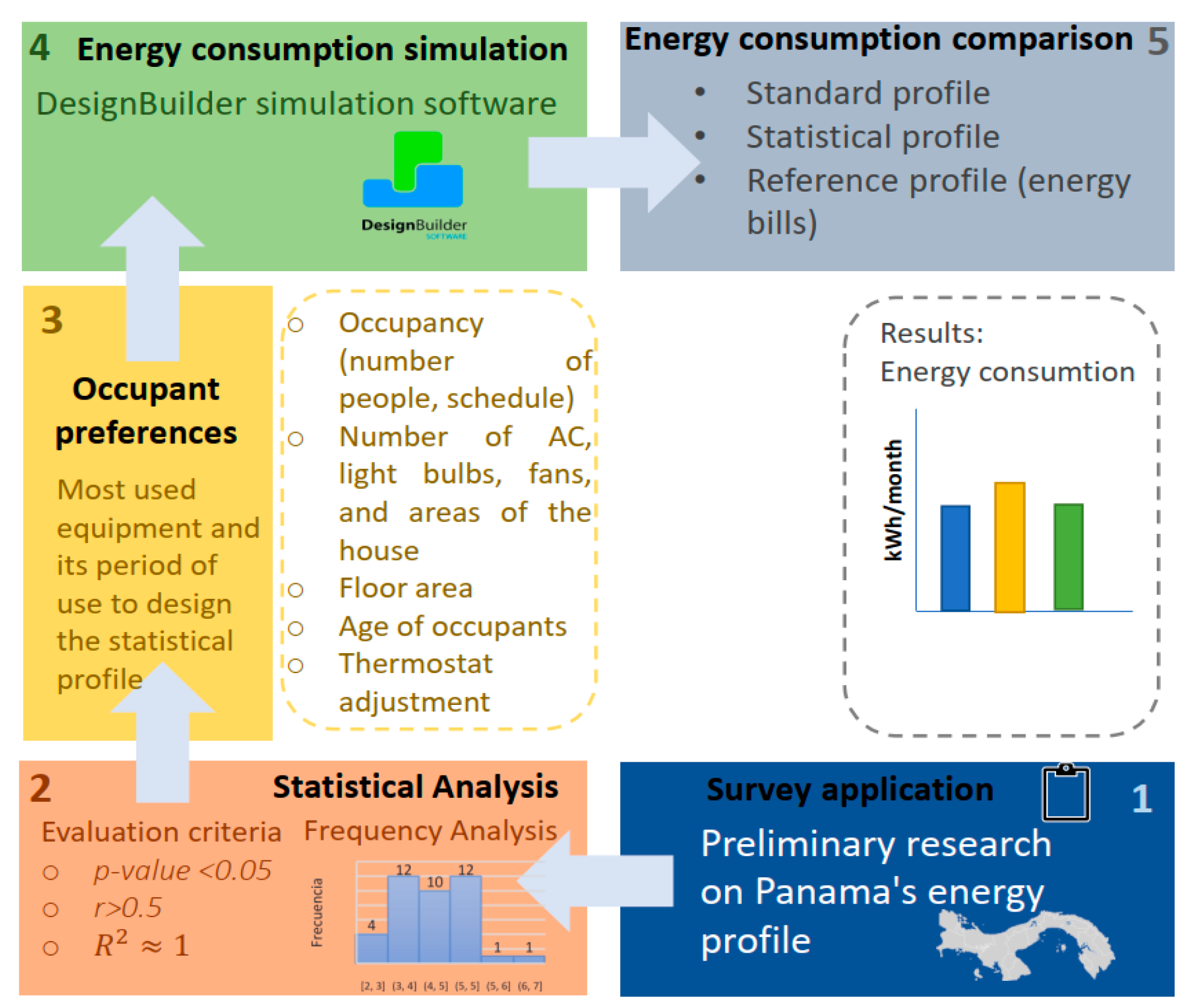
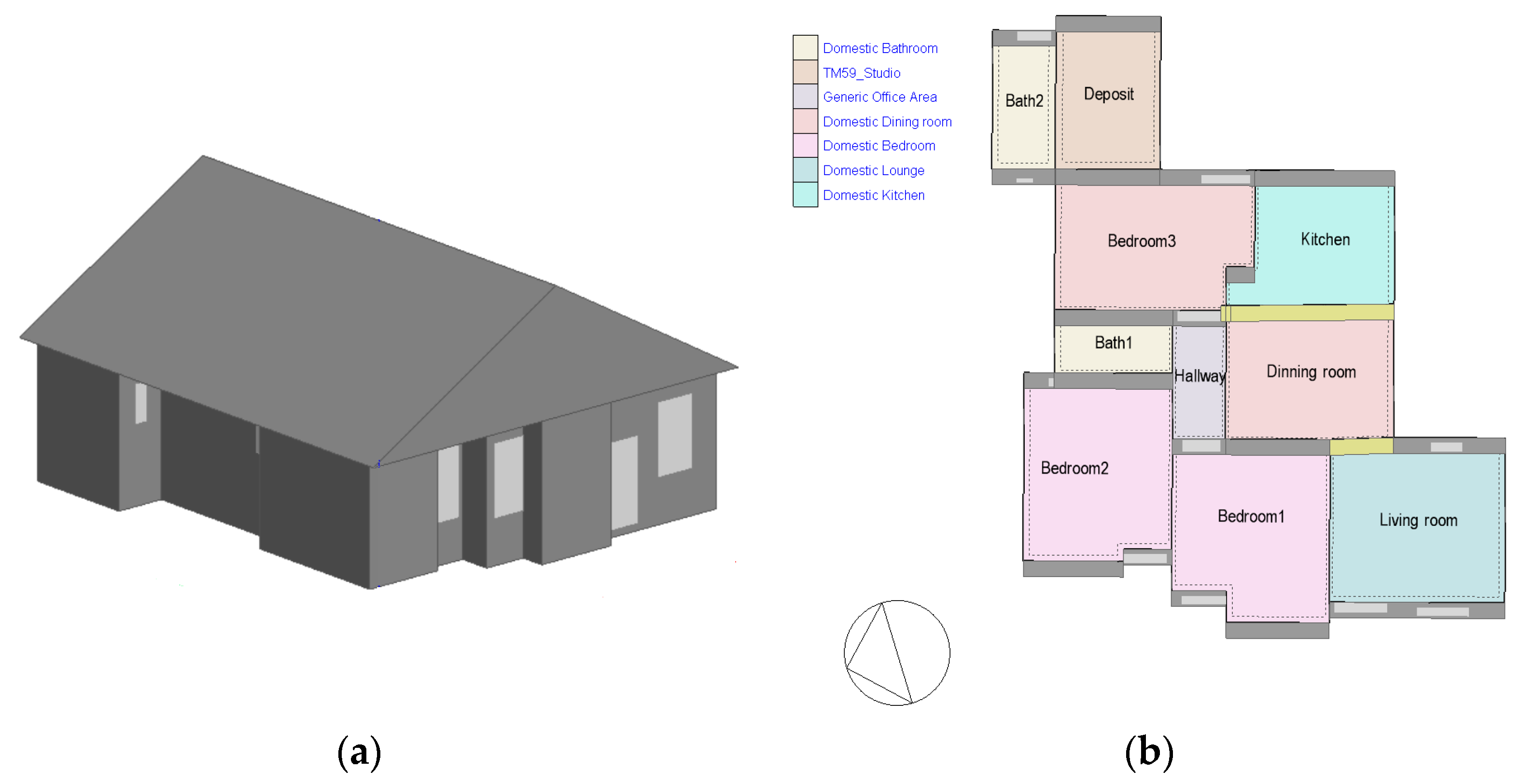
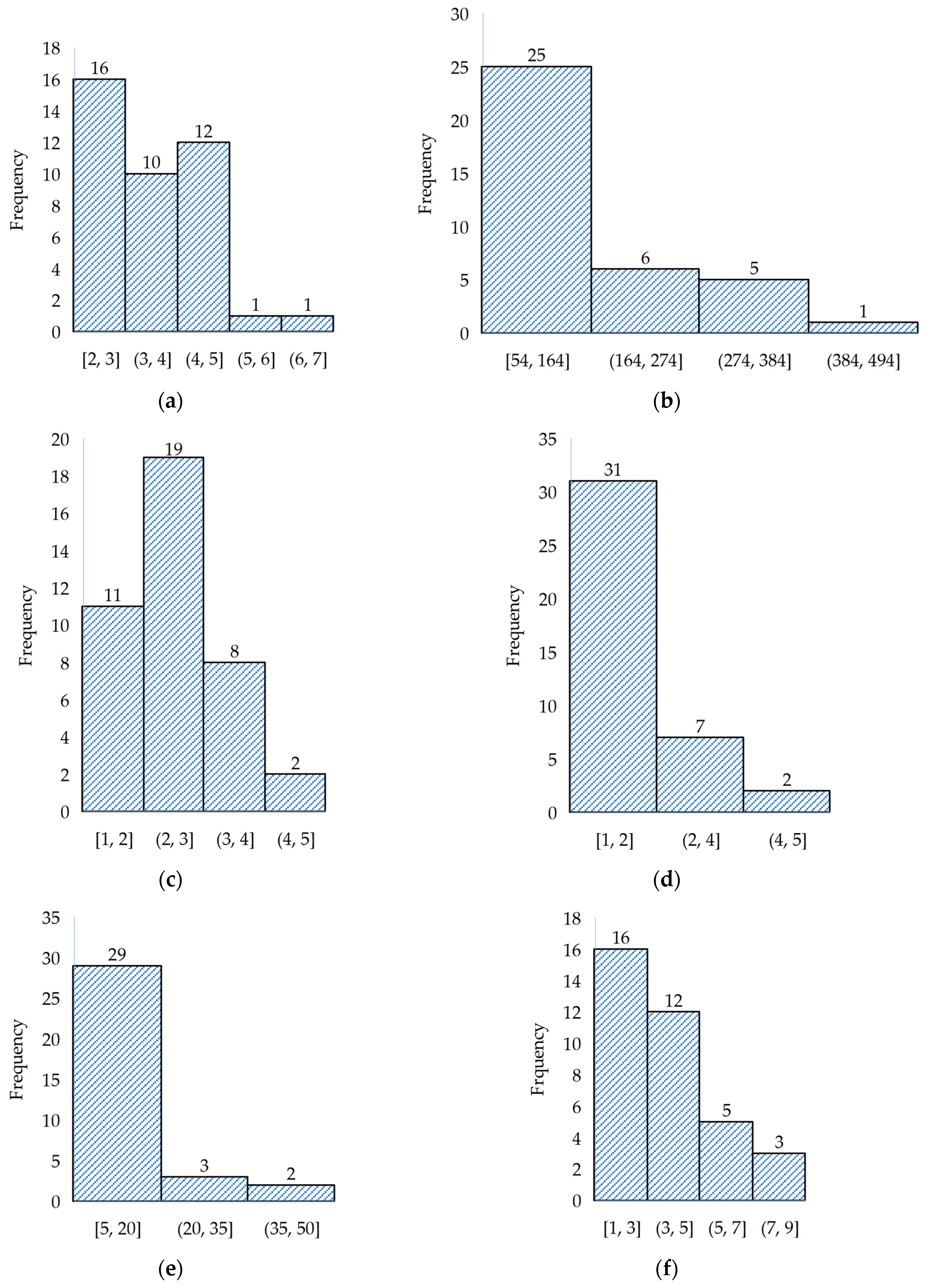
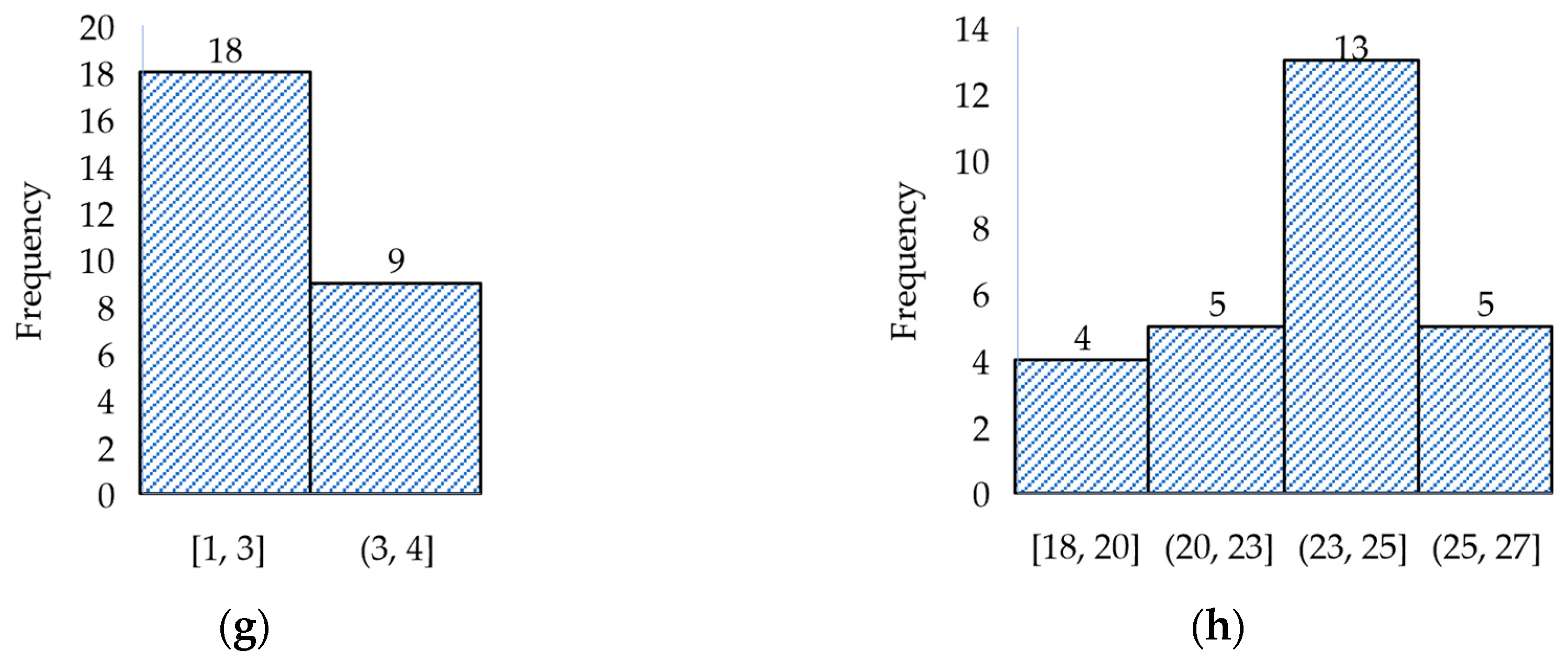
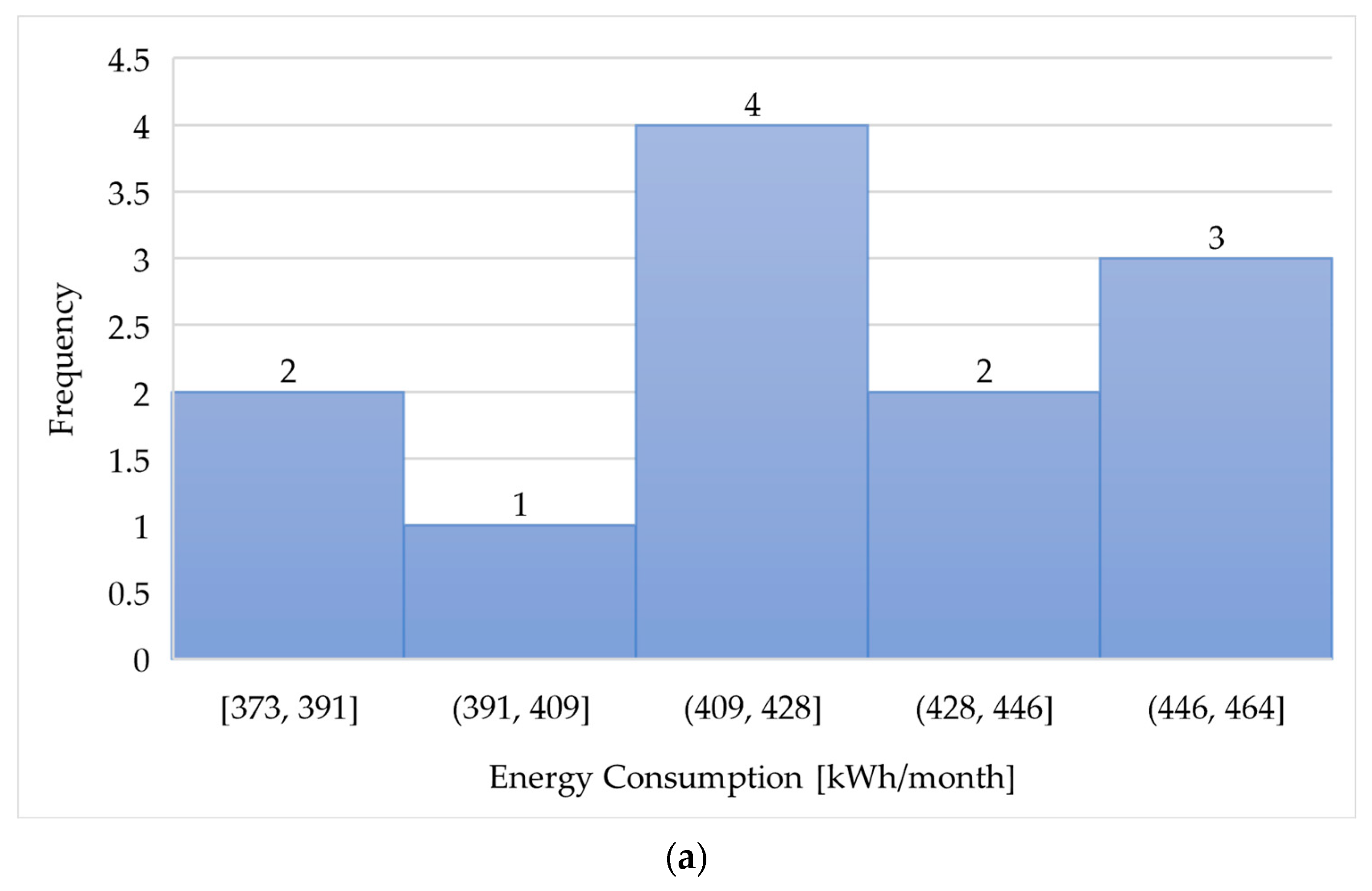
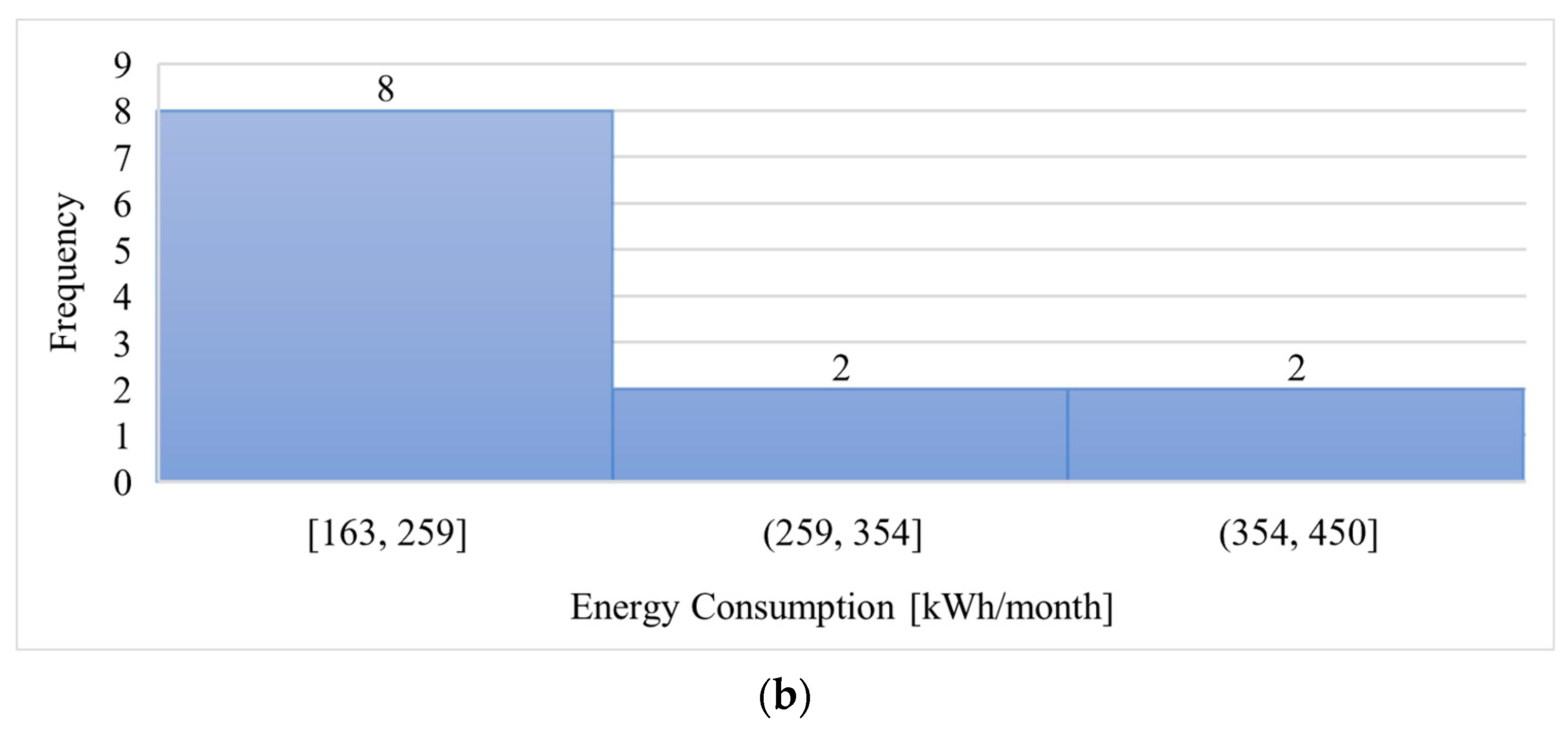
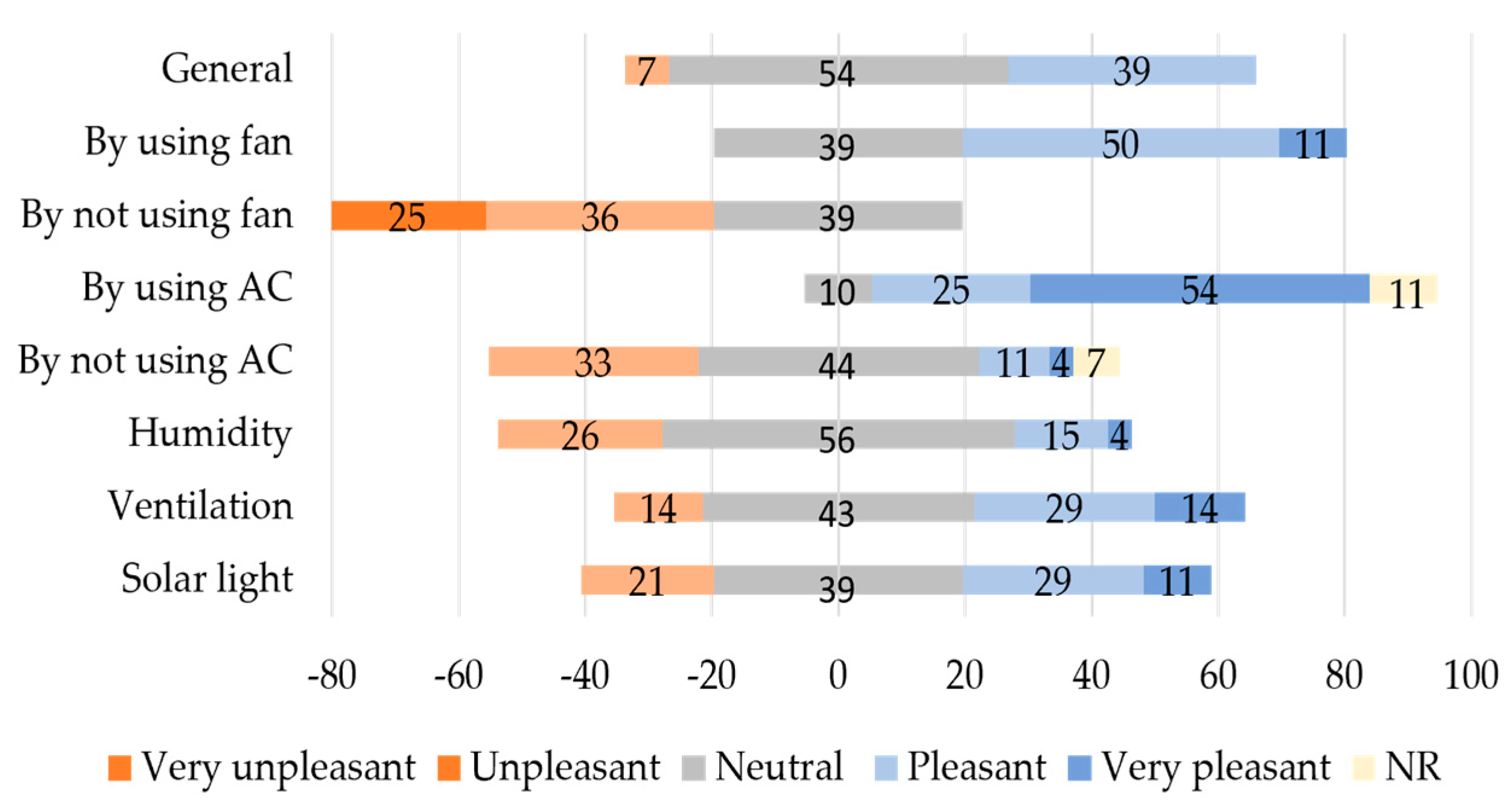
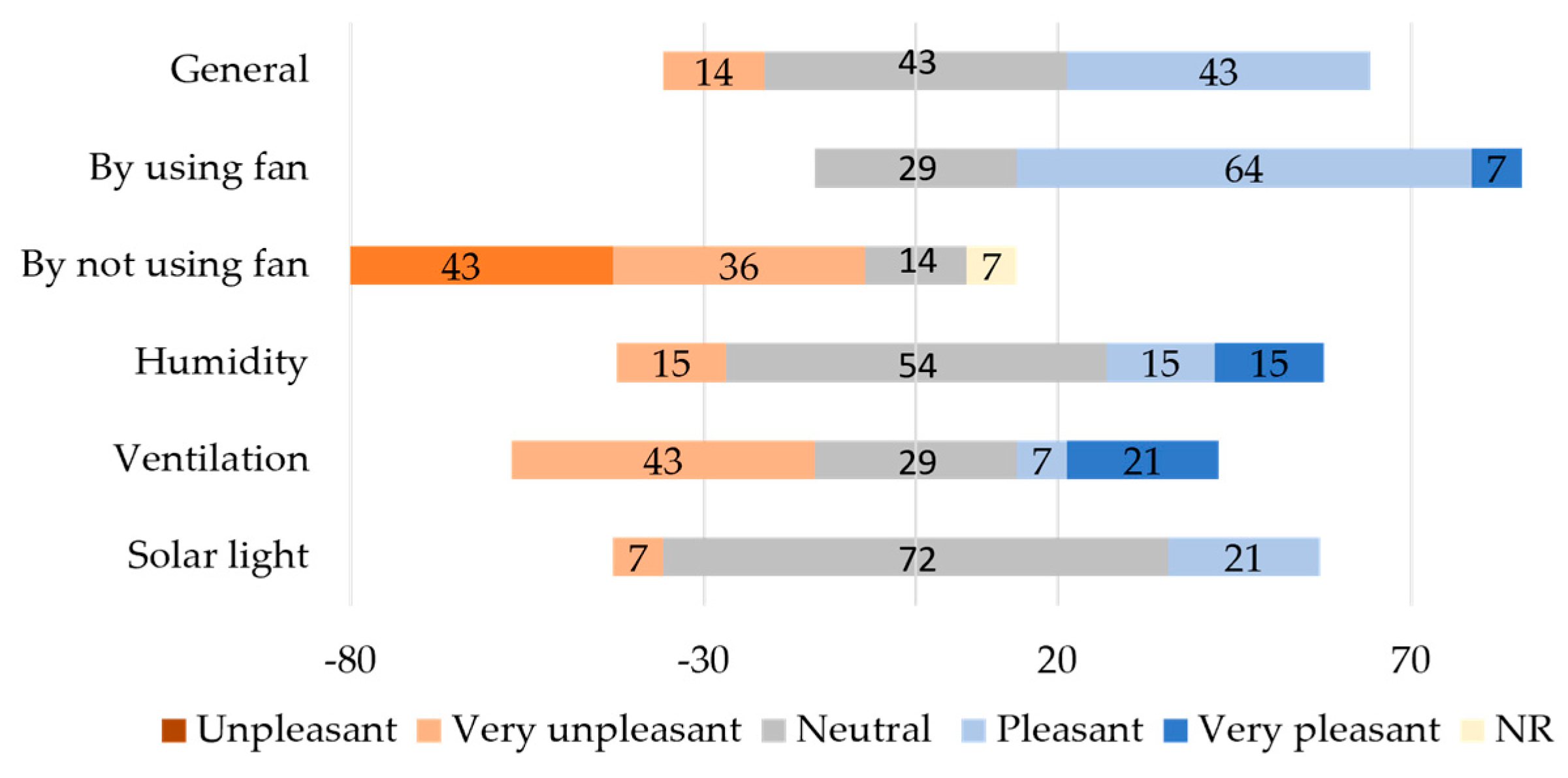

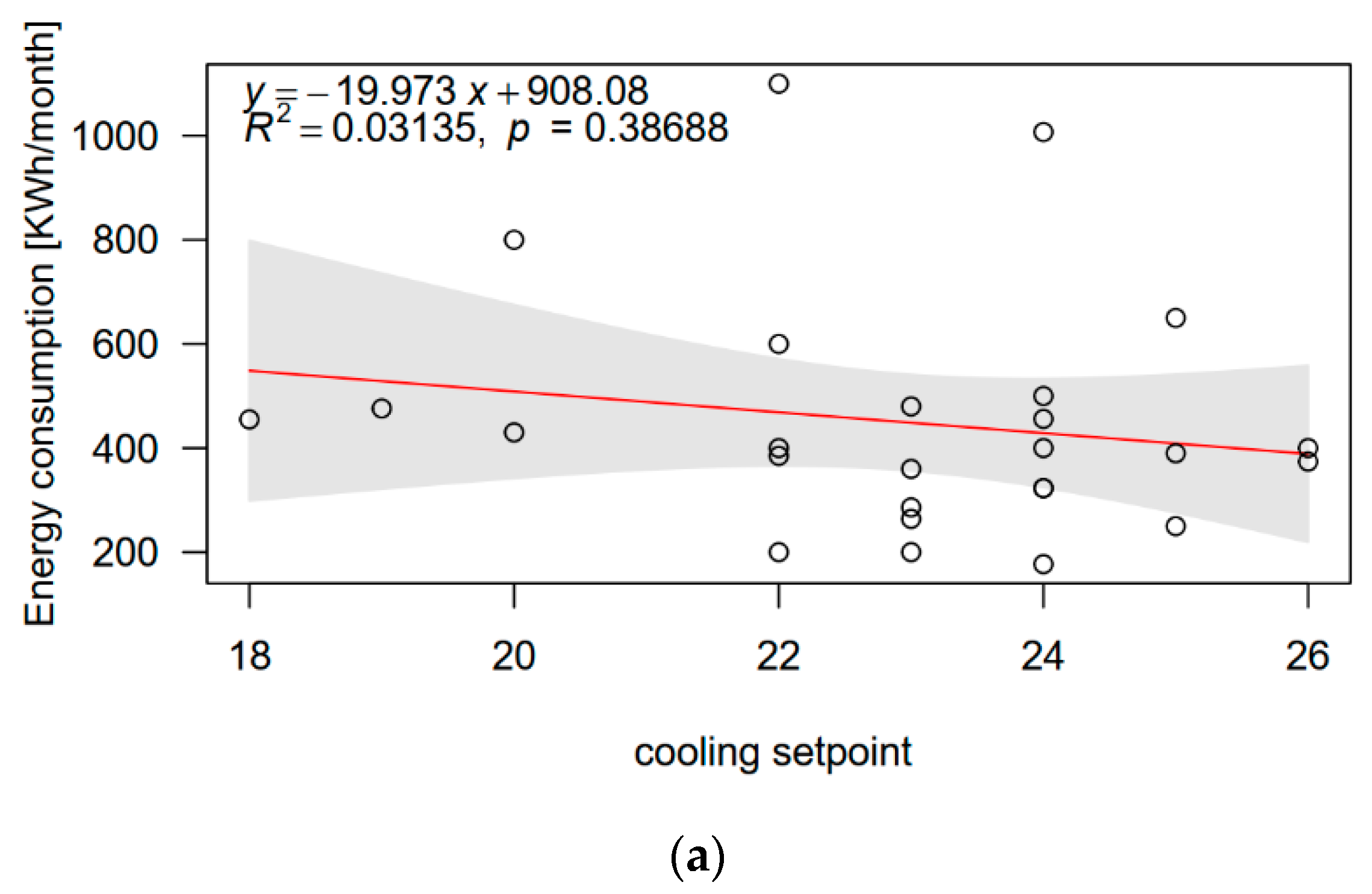
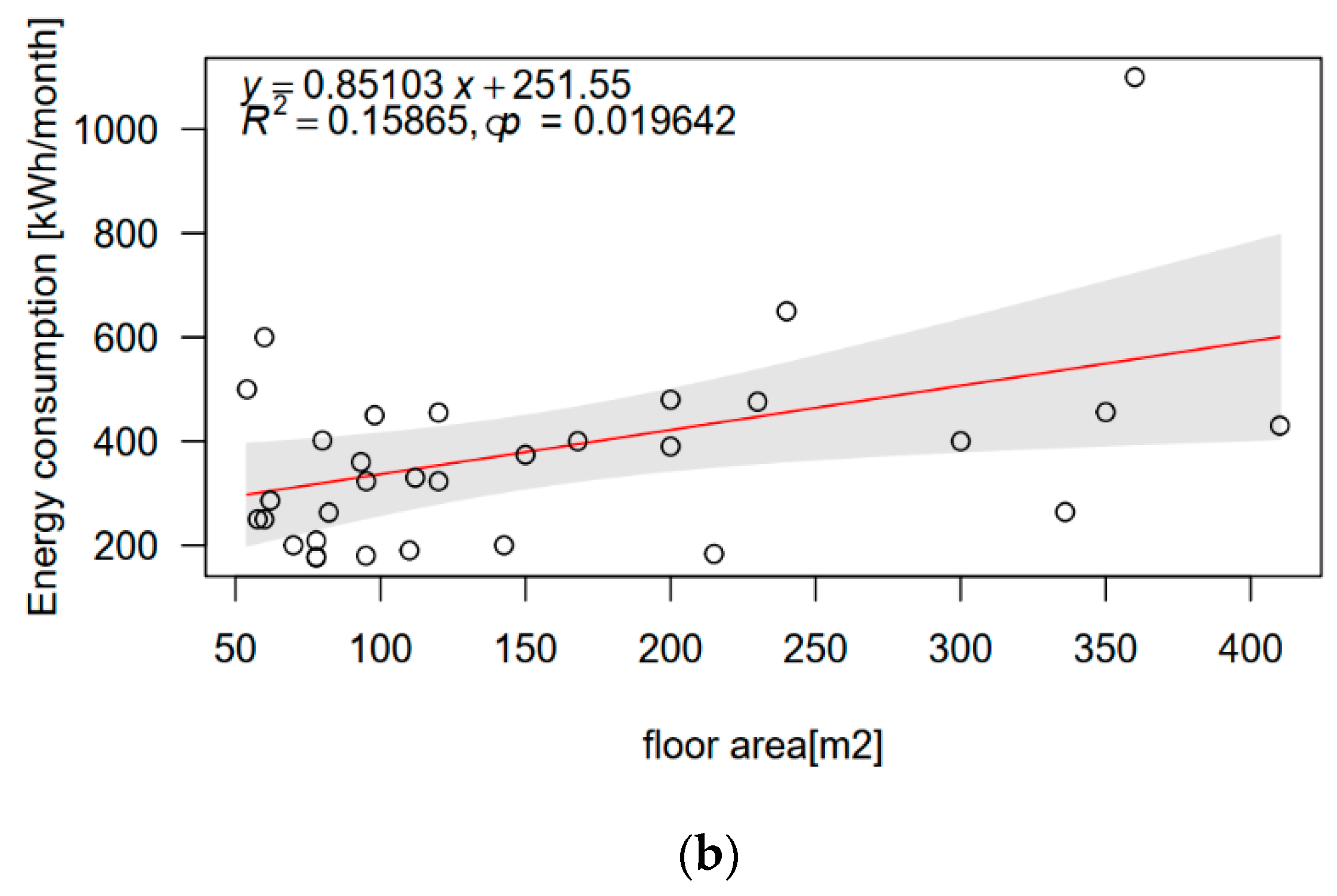


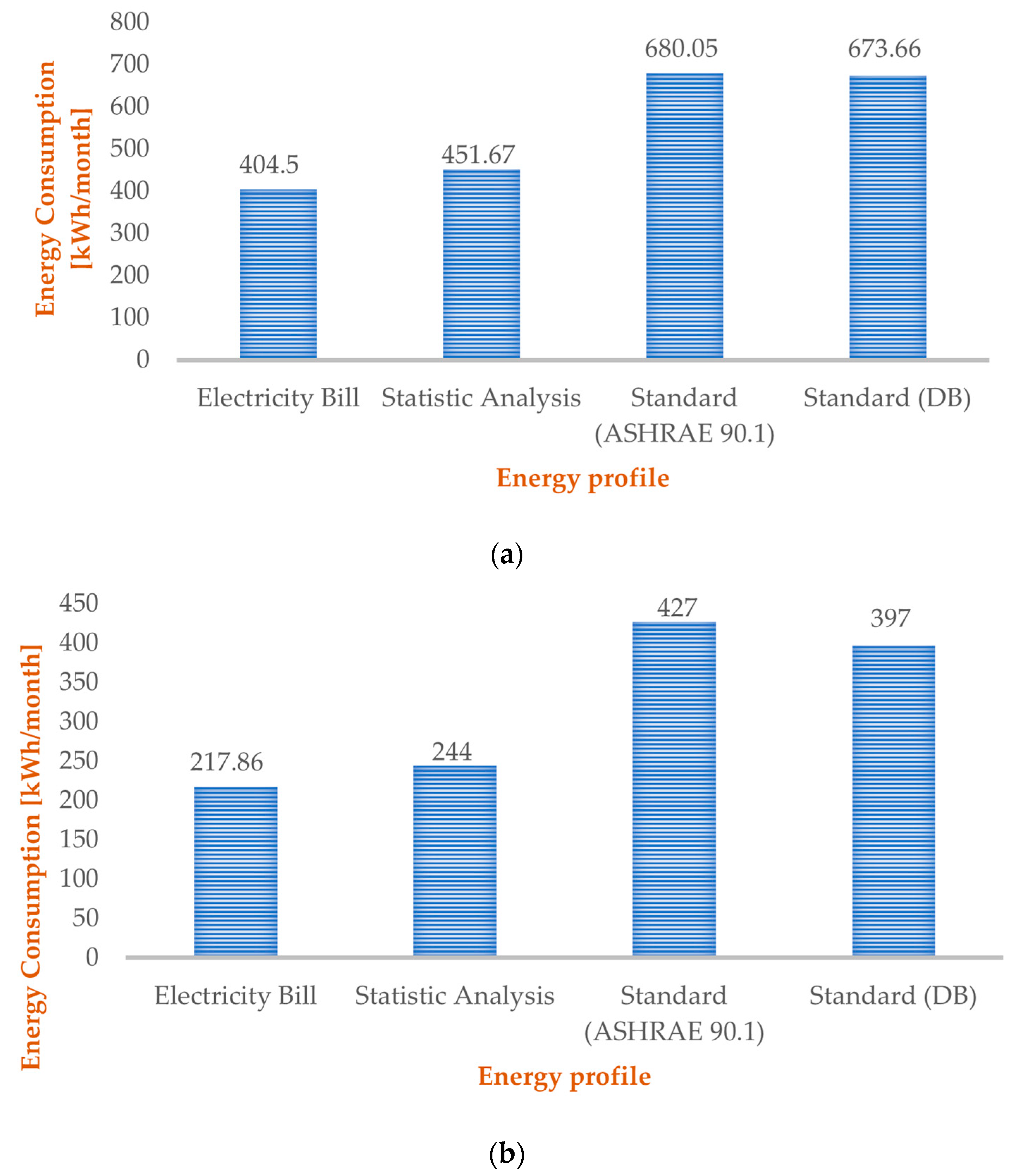
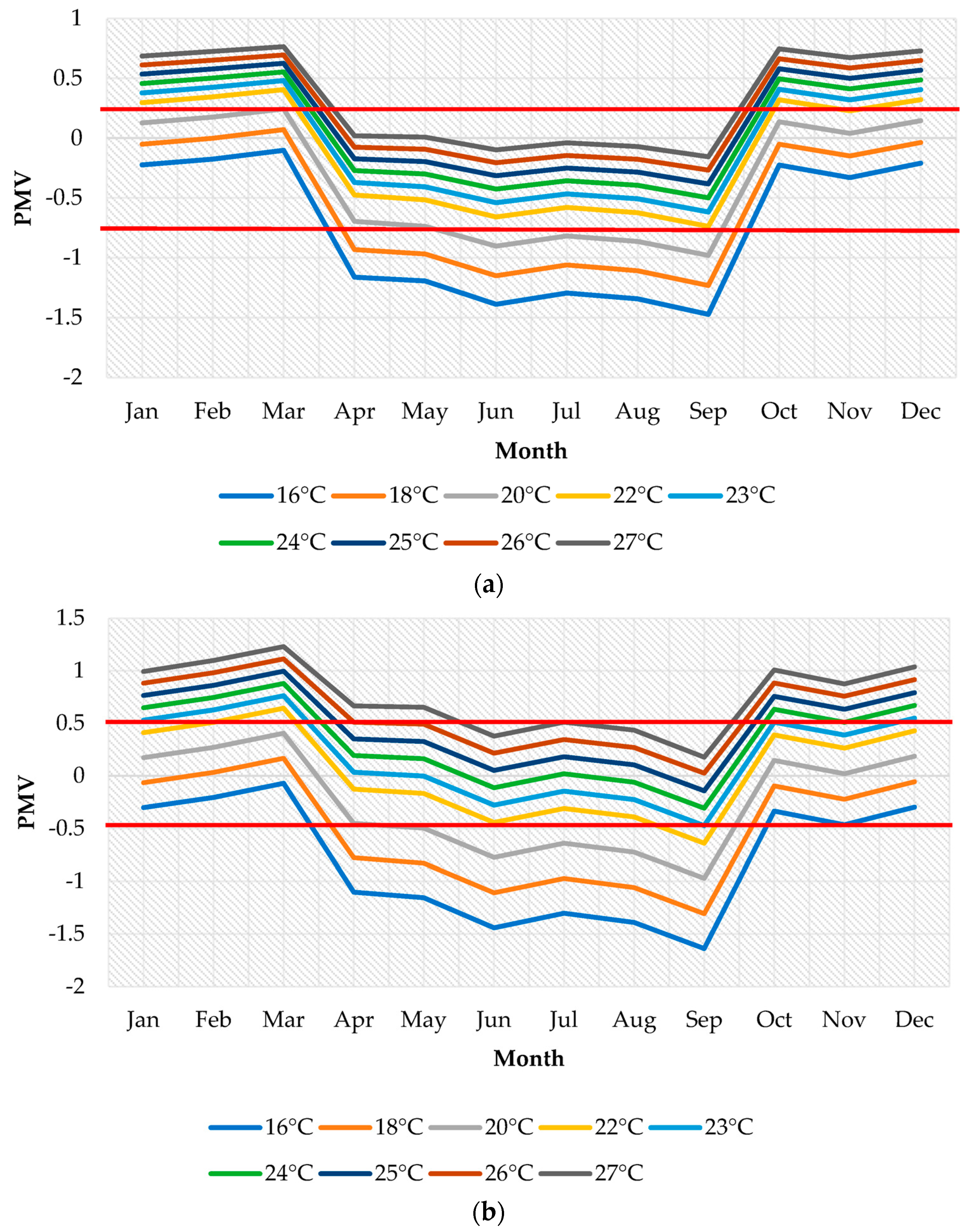

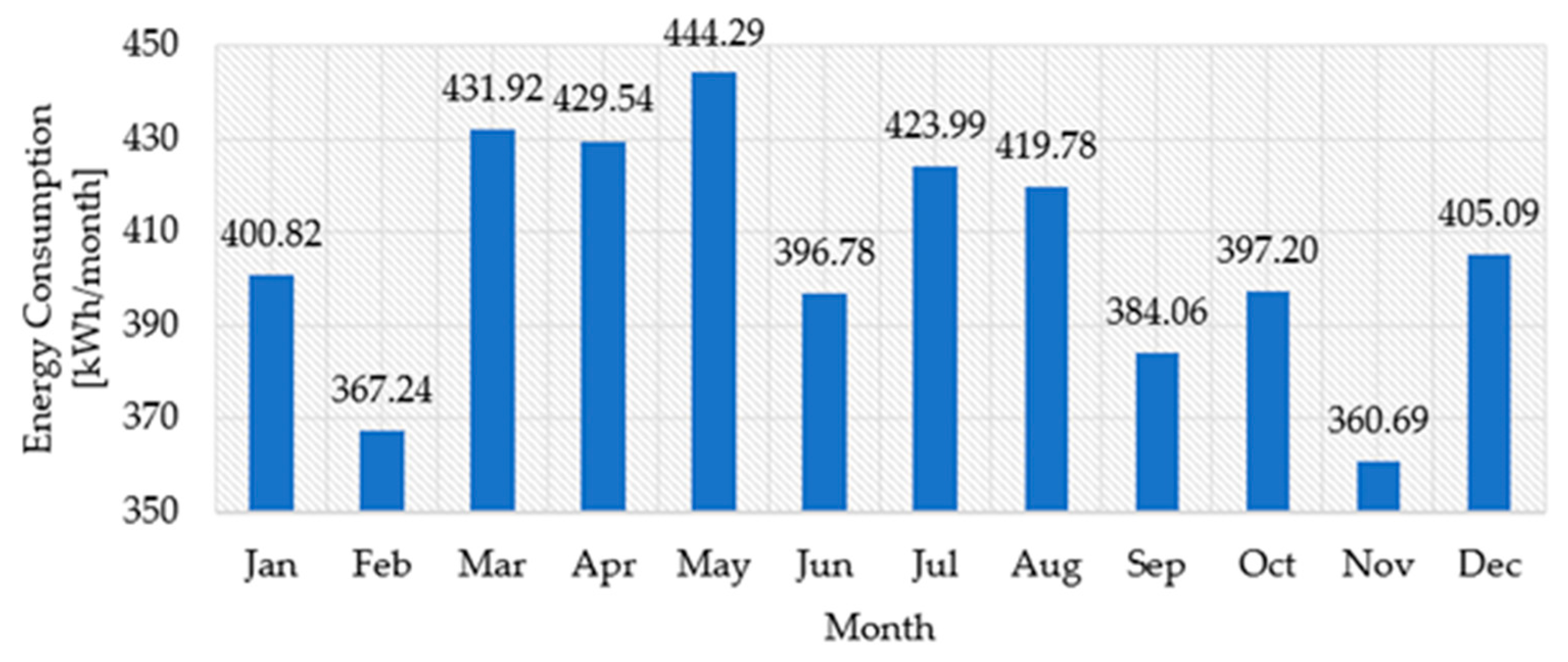
| Wall Material | Thickness [m] | Conductivity [W m/K] |
|---|---|---|
| Painting | 0.001 | 0.3 |
| Plaster | 0.01 | 0.7 |
| Block | 0.1 | 2.3 |
| Plaster | 0.01 | 0.7 |
| Painting | 0.001 | 0.3 |
| U = 1.41 [W m2/K] | ||
| Ranking | |||||||
|---|---|---|---|---|---|---|---|
| A. General Characteristics | B. Cooling and Ventilation Systems | ||||||
| Monthly incomes | % | Type of windows | % | Annual Frequency of AC use | % | Annual Frequency of fan use | % |
| USD 350.00–USD 1825.00 | 45 | Sliding | 60 | Always | 63 | Always | 90 |
| USD 1826.00–USD 3999.00 | 40 | Jalousie | 52.5 | December to April | 30 | Dec to Apr | 8 |
| more than USD 4000.00 | 12.5 | Sash | 2.5 | May to November | 7 | May to Nov | 3 |
| Type of dwelling | Casement | 2.5 | Monthly Frequency of AC use | Monthly Frequency of fan use | |||
| Residence | 82.5 | Awning | 2.5 | Always | 65 | Always | 90 |
| Apartment | 17.5 | Fixed | 2.5 | More than 4 times | 23 | More than 4 times | 10 |
| dwelling status | Type of windows glass | Less than 4 times | 12 | Less than 4 times | 0 | ||
| own | 90 | Sigle glass | 85 | Types of AC | Types of fan | ||
| rented | 10 | Single tinted glass | 7.5 | Split Inverter | 66 | pedestal | 53 |
| Year of construction | Double glass | 7.5 | Split | 24 | ceiling | 37 | |
| After 2000’s | 55 | sun protection for windows | Window | 10 | wall | 8 | |
| 1990–2000 | 10 | Clare paint | 34 | systems during winter | table | 2 | |
| Before 1980 | 10 | Shade trees | 30 | windows opening and fan | 75 | ||
| 1980–1990 | 0 | Orientation | 13 | windows opening | 13 | ||
| Type of ceiling | Insulation in the enclosure | 10 | AC and fan usage | 12 | |||
| Zinc | 52.5 | Eaves | 10 | C. Water Heater and Appliances | |||
| Tejalit | 22.5 | Double gladez window | 4 | Types of stove | % | Energy consumption | |
| concrete | 22.5 | Humidity Issues | gas | 95 | [162.8–382.8] | 54 | |
| Tiles over zinc/wood | 2.5 | Mold | 58 | electric | 5 | (382.8–602.8] | 36 |
| Windows frame materials | Allergies | 42 | Types of water heater | (602.8, 822.8] | 5 | ||
| Aluminum | 75 | Bad odors | 32 | gas | 78 | (822.8, 1042.8] | 3 |
| PVC | 22.5 | Wood warping | 26 | electric | 22 | (1042.8, 1262.8] | 2 |
| Wood | 2.5 | ||||||
| Variable Studied | Frequency Analysis Result | Method Implemented: Frequency Analysis by |
|---|---|---|
| Number of occupants | 4 | Average |
| Floor area | 116 m2 | Mode |
| Number of bedrooms | 3 | Mode |
| Number of bathrooms | 2 | Mode |
| Number of light bulbs | 13 | Mode |
| Number of fans | 3 | Mode |
| Number of AC | 2 | Mode |
| Setpoint temperature | 24 °C | Mode |
| Occupation Profile | ||||
|---|---|---|---|---|
| Number of Occupants | 4 people | |||
| Occupancy hours | % occupation | |||
| 12:00 a.m.–7:00 a.m. | 100 | |||
| 8:00 a.m.–3:00 p.m. | 75 | |||
| 4:00 p.m.–11:00 p.m. | 100 | |||
| Occupant preferences | ||||
| Thermostat adjustment | Temperature | Monthly frequency of use | Annual frequency of use | |
| 24 °C | Every month | Always | ||
| Fan | Every month | always | ||
| Hours of AC use per day | 5 | |||
| Equipment | Quantity | Total hours of use/day | Days/week | |
| Week | Weekend | Frequency of use | ||
| Lights | 13 | 8 | 8 | 7 |
| Computers or printers | 2 | 07:35 | 07:00 | 7 |
| Sound equipment | 1 | 04:50 | 04:05 | 3 |
| Television | 2 | 07:45 | 09:13 | 7 |
| Microwaves | 1 | 00:35 | 00:20 | 6 |
| Refrigerator | 1 | 24:00 | 24:00 | 7 |
| Clothes iron | 1 | 00:35 | 00:45 | 2 |
| Washing machine | 1 | 01:45 | 02:00 | 2 |
| Equipment | Period of Use | |||
|---|---|---|---|---|
| Natural ventilation | Monday–Sunday | 24 h | ||
| Air conditioning (only for the house that applies it) | Monday–Sunday | 8:00 a.m.–7:00 p.m. | 24 °C | |
| Refrigerator | Monday–Sunday | 24 h | ||
| Computer | Monday–Sunday | 8:00 a.m.–7:00 p.m. | ||
| Period of occupation and illumination | Period of occupation, lighting, use of equipment | |||
| Dining room-Schedule | % | Kitchen-Schedule | % | |
| (12:00 a.m.–6:00 a.m.) | 0 | (12:00 a.m.–7:00 a.m.) | 0 | |
| (6:00 a.m.–7:00 a.m.) | 25 | (7:00 a.m.–10:00 a.m.) | 100 | |
| (7:00 a.m.–9:00 a.m.) | 100 | (10:00 a.m.–7:00 p.m.) | 0 | |
| (9:00 a.m.–10:00 a.m.) | 25 | (7:00 p.m.–11:00 p.m.) | 20 | |
| (10:00 a.m.–6:00 p.m.) | 0 | (11:00 p.m.–12:00 a.m.) | 0 | |
| (6:00 p.m.–7:00 p.m.) | 50 | |||
| (7:00 p.m.–9:00 p.m.) | 100 | |||
| (9:00 p.m.–10:00 p.m.) | 30 | |||
| (10:00 p.m.–12:00 a.m.) | 0 | |||
| Occupancy, mechanical ventilation and lighting of rooms on weekdays and weekends | Period of occupation, lighting, mechanical ventilation | |||
| Schedule | % | Room-Schedule | % | |
| (12:00 a.m.–7:00 a.m.) | 100 | (12:00 a.m.–4:00 p.m.) | 0 | |
| (7:00 a.m.–8:00 a.m.) | 50 | (4:00 p.m.–6:00 p.m.) | 50 | |
| (8:00 a.m.–9:00 a.m.) | 25 | (6:00 p.m.–10:00 p.m.) | 100 | |
| (9:00 a.m.–10:00 p.m.) | 0 | (10:00 p.m.–11:00 p.m.) | 66 | |
| (10:00 p.m.–11:00 p.m.) | 25 | (11:00 p.m.–12:00 a.m.) | 0 | |
| (11:00 p.m.–12:00 a.m.) | 75 | |||
| Equipment | Period of Use | |||
|---|---|---|---|---|
| Natural ventilation | Monday–Sunday | 24 h | ||
| Air conditioning (only for the house that applies it) | Monday–Sunday | 8:00 a.m.–7:00 p.m. | 24 °C | |
| Refrigerator | Monday–Sunday | 24 h | ||
| Computer | Monday–Saturday | 8:00 a.m.–7:00 p.m. | ||
| Period of occupation of the residence | % | Period of occupation, lighting, use of equipment | % | |
| (12:00 a.m.–5:00 a.m.) | 100 | (12:00 a.m.–6:00 a.m.) | 0 | |
| (5:00 a.m.–6:00 a.m.) | 80 | (7:00 a.m.–10:00 p.m.) | 100 | |
| (6:00 a.m.–8:00 a.m.) | 75 | (10:00 p.m.–11:00 p.m.) | 80 | |
| (8:00 a.m.–9:00 a.m.) | 50 | (11:00 p.m.–12:00 a.m.) | 20 | |
| (9:00 a.m.–3:00 p.m.) | 43 | |||
| (3:00 p.m.–6:00 p.m.) | 50 | |||
| (6:00 p.m.–9:00 p.m.) | 75 | |||
| (9:00 p.m.–12:00 a.m.) | 80 | |||
Disclaimer/Publisher’s Note: The statements, opinions and data contained in all publications are solely those of the individual author(s) and contributor(s) and not of MDPI and/or the editor(s). MDPI and/or the editor(s) disclaim responsibility for any injury to people or property resulting from any ideas, methods, instructions or products referred to in the content. |
© 2023 by the authors. Licensee MDPI, Basel, Switzerland. This article is an open access article distributed under the terms and conditions of the Creative Commons Attribution (CC BY) license (https://creativecommons.org/licenses/by/4.0/).
Share and Cite
González, J.; Mora, D.; Chen Austin, M. Energy Consumption Difference Found between Typical and Standard Occupancy in Residential Buildings in a Tropical Developing Country. Buildings 2023, 13, 2235. https://doi.org/10.3390/buildings13092235
González J, Mora D, Chen Austin M. Energy Consumption Difference Found between Typical and Standard Occupancy in Residential Buildings in a Tropical Developing Country. Buildings. 2023; 13(9):2235. https://doi.org/10.3390/buildings13092235
Chicago/Turabian StyleGonzález, Jinela, Dafni Mora, and Miguel Chen Austin. 2023. "Energy Consumption Difference Found between Typical and Standard Occupancy in Residential Buildings in a Tropical Developing Country" Buildings 13, no. 9: 2235. https://doi.org/10.3390/buildings13092235
APA StyleGonzález, J., Mora, D., & Chen Austin, M. (2023). Energy Consumption Difference Found between Typical and Standard Occupancy in Residential Buildings in a Tropical Developing Country. Buildings, 13(9), 2235. https://doi.org/10.3390/buildings13092235







